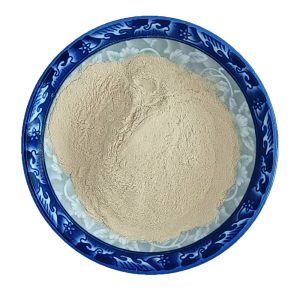Product Description
Alternate names/aliases:
Heat-Stable Phytase
Intrinsic Heat-Stable Phytase (microbial phytase)
Thermostable Phytase Enzyme (feed enzyme)
Micro-granulated phytase / Powder phytase / Liquid phytase
Overview
Heat-Stable Phytase is an industrial feed enzyme designed to hydrolyse phytate-bound phosphorus in plant raw materials and unlock otherwise inaccessible phosphorus, improving growth performance, mineral uptake, and feed conversion while reducing phosphorus load in manure. Available in multiple physical forms (powder, granule, water-soluble powder, and liquid) and activity grades from 5,000 to 300,000 U/g to fit premix, on-farm, and post-pelleting application strategies.
Key technical specifications
| Item | Typical value/range |
|---|---|
| Activity (declared) | 5,000 – 300,000 U / g (product variants). |
| Unit definition | 1 FTU (or U) = amount of enzyme liberating 1 µmol inorganic phosphate/min from sodium phytate at pH 5.5, 37°C (ISO standard assay). |
| Formulations | Powder (free-flowing), micro-granule, water-soluble powder, liquid concentrate. |
| pH activity range | Typically active between pH ~2.5–6.5, depending on source; peak activity is often ≈ pH 5.5 for many feed phytases. |
| Optimum temp (assay) | Typical activity peak ~45–60°C; thermostability engineered for survival of short pelleting pulses up to ~85–90°C in heat-stable grades. |
| Heat stability | Intrinsic heat-stable phytases can retain high recovery at 85°C and significant activity at 90°C (specific recovery depends on grade/coating). |
| Appearance/bulk | Light brown powder or off-white granules; microgranules are virtually dust-free and free-flowing. |
| Solubility | Water-soluble grades dissolve per the supplier’s datasheet; microgranules are intended for premix addition. |
| Moisture/stability | Low moisture (<8–12%) recommended; store dry and sealed. Shelf life typically 12–24 months for solids (common commercial values 18–24 months) — check grade. |
| Packing | 1 kg / 25 kg (kraft paper bag + PE liner) or bulk drums/totes for liquid. |
| HS Code | 3507.90 (Enzymes; prepared enzymes — “other”). |
| (Values above are ‘typical’ — always use supplier COA / SDS for exact lot values.) |
In-depth physical & chemical properties
Nature & composition: a proteinaceous enzyme (microbial origin, commonly Bacillus or fungal Aspergillus strains). Molecular weight and glycosylation vary by source — reported enzyme masses commonly range ~38–100 kDa, depending on strain and glycosylation. Activity expressed in FTU/U (see unit definition above).
pH profile & IEP: Many commercial phytases are acidic phytases with max activity near pH 5.5; some bacterial phytases show broader/alkaline profiles (useful for specific digestive tract targets).
Thermostability: Thermostability is determined by intrinsic protein stability and by formulation (coating, microgranulation). Intrinsically heat-stable phytases (or coated granulates) retain a high % recovery after pelleting at 80–90°C; non-heat-stable forms lose activity and are better added post-pelleting.
Physical handling: powders may be dusty — micro-granulated forms reduce dust and improve weighing accuracy in premix lines. Liquid concentrates used for post-pellet application require dosing pumps and mixing.
Typical inclusion rates & application examples
Important: Dosage must be expressed in FTU (U) per kg of complete feed. Always use product COA and perform on-site pelleting/retention tests for your process.
Standard industry practice (guideline): 500 FTU/kg of complete feed is a commonly used single dose for broilers and pigs; many suppliers and regulators provide matrices up to 500 FTU/kg; commercial ranges extend from 100 to 2,000 FTU/kg depending on product strategy (maintenance vs. super-dosing). For layers, lower levels (300–400 FTU/kg) are typical for phosphorus replacement strategies.
By species/objective (examples):
Broilers (growth & FCR focus): 500 FTU/kg typical; super-dosing (≥1,000–1,500 FTU/kg) may be used to maximize nutrient release and gut benefits in specific programs.
Layers: 300–400 FTU/kg, typically recommended for P matrix use and shell/bone quality; consult layer matrix values.
Piglets / Grower-Finisher: 250–500 FTU/kg typical; higher doses sometimes used for improved digestibility.
Sows: 500 FTU/kg recommended in several regulatory assessments for sows to support P nutrition.
Cattle/ruminants: phytase effects are less straightforward (rumen dephosphorylation); consult species-specific trials before use.
Recommended addition & processing methods
Premix/batch mixing (micro-granules or powder)
Add the enzyme as the last minor ingredient into the mixer for even distribution. Micro-granulated, free-flowing grades reduce dust and segregation risk. Target homogeneous mixing (follow mill SOP).
Pelleted feed (high temperature)
Use intrinsically heat-stable phytase granules (specified for pelleting) or apply enzyme post-pelleting as a liquid spray/coating to avoid thermal inactivation. Post-pelleting liquid application systems must ensure uniform coating and correct dosing (g/ton scale).
Water-soluble grades / on-farm
Dissolve per supplier instructions; commonly used for spraying or medicator dosing. Follow stability and storage guidance (use freshly prepared solutions per SDS).
Quality checks
Validate phytase recovery after pelleting with in-house or 3rd-party enzyme assay (post-pellet assay) to confirm expected FTU retention in finished feed.
Storage, shelf life & handling
Store in a cool, dry place, sealed; avoid humidity, temperature extremes, and prolonged sunlight. Typical shelf life for solid forms: ~18–24 months when stored at recommended conditions; liquid grades often have shorter shelf life (e.g., 6–18 months depending on formulation). Confirm shelf life on COA/SDS.
Safety: enzyme powders can be respiratory sensitisers — provide SDS, recommend dust control, PPE (masks/gloves), and follow local occupational guidance. Use micro-granulated forms to reduce dust exposure.
Packaging & logistics
Standard: 1 kg / 25 kg kraft paper bags with inner PE liner for powder/granules; 1,000 L IBCs or drums for liquids. Custom packing available for OEM/retail. HS Code 3507.90 for customs.
Regulatory & quality notes
Many commercial phytases are registered/assessed by regulatory bodies (e.g., EFSA assessments exist for specific commercial phytases). Dosage limits and claims should follow local feed additive regulations and the supplier’s authorized labelling. Suppliers commonly provide COA, SDS, and may provide FAMI-QS / ISO documentation on request.
Sources & references
ISO / industrial phytase activity & Natuphos technical info (unit definition, dosage matrix). download.basf.com+1
EFSA / regulatory dosage recommendations & assessments. Food Safety
Huvepharma & OptiPhos reports — intrinsic heat stability and pelleting recovery discussion. huvepharma.com+2huvepharma.com+2
Peer-reviewed reviews on phytase benefits (phosphorus availability, digestibility). PMC
Practical product pages and industry guidance on forms (micro-granules, liquid for post-pellet). @dsm-firmenich+1
HS code reference for enzymes: 3507.90. Descartes Datamyne


